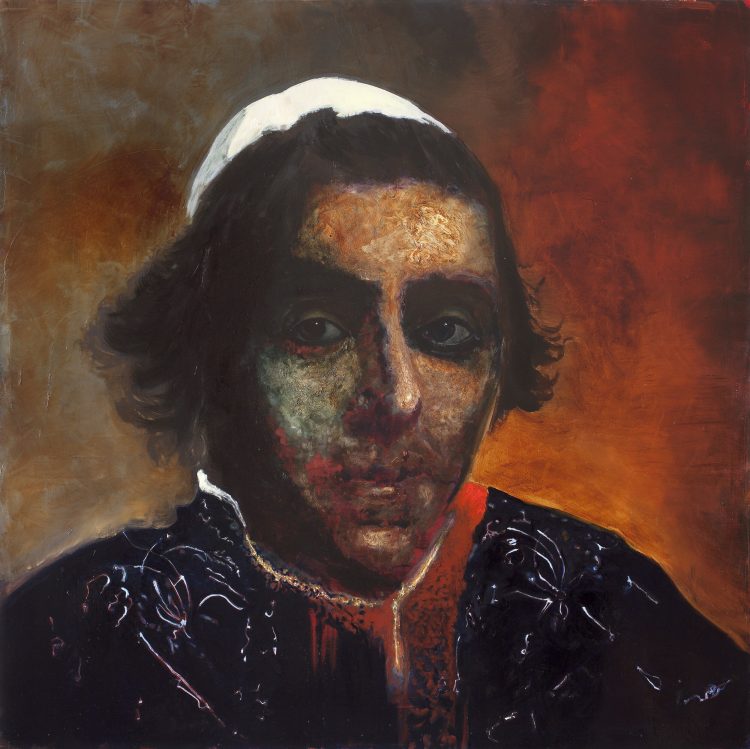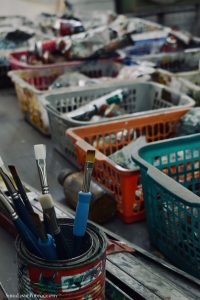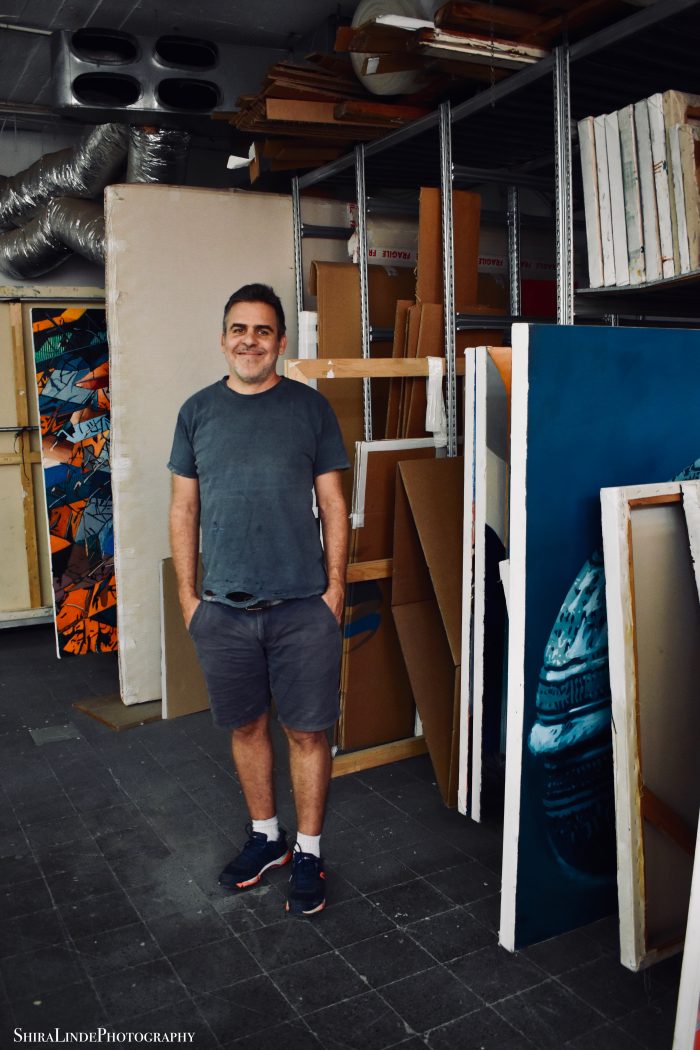Sherman Fairchild Fellow Ariana Kaye visited the studio of Oren Eliav in Tel Aviv Israel. Eliav’s Listener, 2012, was recently acquired by The Phillips Collection, and is featured in the major centennial exhibition Seeing Differently: The Phillips Collects for a New Century.

Oren Eliav, Listener, 2012, Oil on canvas, 59 x 59 in., The Phillips Collection, Gift of Tony Podesta, 2020
AK: The work in The Phillips Collection is from Listeners. Tell us more about the series and its ongoing iterations. Where does the title come from and what was your biggest source of inspiration for the series? There’s some works I’m seeing from the series—that one over there and that one right on the wall over there, yeah?
OE: Yeah, they keep me company. You know, Listeners is a series that I’ve been working on for a long time.
AK: Since 2004, right?
OE: Something like that . . . I have thought about it in many different ways since the series’ inception.
AK: People live with the art and look at it and it doesn’t have one explanation because it’s not static . . . the work develops its own life, and lives within the world too.
OE: Exactly, things always change, including interpretations. I imagine these figures listening to something. I can say it is a portrait of a man. Just like any other portrait. The title is what shifts the attention—“Listener”—there must be sound in this painting, but I can’t hear it because painting is always mute. Sound also implies space. We can learn about space from sound. We can locate things without seeing them. A knock on our door or a distant bird. So, this “Listener” must inhabit a space, but I am not privy to it directly, only by imagination.
AK: A commentary on your work was talking about how the people in these paintings are in a confessional. So, you’re not privy to that, because in that structure of a confessional, there are those walls. There is a sliding window that opens, with someone sitting on the other side, and it’s closed off. Then one usually tells the priest, “Well, I sinned, “Well I did something I should not have . . . please forgive me.”
OE: Yeah, the Phillips work is a priest, it is based on the portrait of Pope Pius VII by Jacques Louis David. Only a few years after painting it did I realize that the man in the painting could be listening to a confession, so it opened this level of interpretation, but I admit it was an afterthought. Meanings in paintings often appear in retrospect, not in their making.
AK: It’s an expressive medium, yeah.
OE: And it is only when meeting Ariana, or any other art historian, critic, or just a curious person that I find myself explaining my work. Art historians and writers enrich us with their interpretations and reflections, but the truth, the hardcore truth of paintings, is that they are utterly mysterious and unexplainable objects.
AK: That’s what makes the role of an art historian so difficult, because we have to say, “Oh, this painting means this or this painting means that,” then the artist will say the interpretation is up to the viewer. We’re kind of like investigators, but you’re also an investigator mining for meaning, because, like Dr. Nikro writes your work utilizes “material archaeologies” so art historians are archaeologists, but you’re also kind of an archaeologist. How do you see your practice as the work of an archaeologist mining for materials, meaning, and imagery?
OE: Wow, that’s an amazing question. first let me say that we’re all looking for meaning, that’s true.
AK: What is the meaning of life? Yeah, the biggest question of all questions.
OE: Yes, we spend all our life looking for meaning, and as we do it, we generate more meanings. This is how culture works, a mirror hall of meanings. To continue your comparison between art making and archeology and mining, I would only comment that I feel that underneath all these layers lies a deep mystery, a generous void from which things keep emerging. We live while trying to make the connections between them. Also, I am not really sure how the word “meaning” really pertains to art. Is meaning a sentence that replaces a sculpture? A well-articulated motive for the artist? Does a blue triangle in a painting carry a different meaning then an orange triangle? Looking for meaning in a painting means it has a purpose or a message. And painting with a message is called a poster, right?
AK: In essence, going back to Listeners, you’re kind of mining the archive in a way, the art historical archive and kind of thinking about what it all means, and especially with The Death of Lucretia for example—what her story was and what the significance of it was and how the fragmentation can kind of point to, okay, what happened and how do we make meaning of this and how do we move forward so? I mean, that’s my interpretation . . .

Oren Eliav studio. Photo: Shira Linde
OE: In my work I definitely pursue patterns, stories, relationships, associations, and interpretations, and I hope the viewer, the writer, or the art historian will engage in the same process. In How to Disappear Completely, the story of Lucretia and the specific source painting of Giovanni di Paolo indeed led to a wealth of different ways of looking and thinking and experiencing it.
AK: There was a quote you said in one text that was talking about how art history is not this linear thing, that all ideas kind of live in a room and they are intertwined and combined with each other and mixed with each other and create vibrations or sounds that result in new possibilities, I loved that.
OE: Thank you. Yes, this is a very simple fact about how we experience art. When you go about The Phillips Collection for example, hanging on the walls are objects created during different points in time, but they are appearing to you at this moment, the moment you encounter them. In addition, they have external information attached to them . . .
AK: Essays, texts . . .
OE: Yes, and also provenance.
AK: The work lived here, and it lived there—it lived multiple lives before you encountered it. It lived in this museum and this rich man’s house and then the Medici Palace…
OE: Exactly. So, if you are a sleuth of paintings, it’s nice to have this external information. It certainly enriches your experience, but it is not indispensable. The fact that a painting was made in 1836 or in 1428 is not the main factor in my opinion. It is the fact that you have an object filling your field of view right now and that it is making you feel and think in a certain way, during the moments you are standing in front of it.
AK: So you started to talk about painting as a different medium than verbal and sound communication. How can you let us in on your artistic process? I see all your paintbrushes and paints and everything. How do you make these incredible works? What’s the process of making?
OE: Thank you, first.
AK: The works are incredible. I got hooked through everything online and at the Phillips and now at the National Gallery, too.
OE: In a way I believe in full preparation along full improvisation, like both at the same time. I like to think I know what I’m doing, then be surprised. The first part is done digitally, I mean my sketchbook is just the computer.
AK: Can you show us some?
OE: Yes of course. I make many sketches, most of them in greyscale. The next step is to choose one and transfer it to the physical canvas, which I built, stretched, and prepared beforehand. After that it is like having a map on the canvas, a scaffolding made to hold future actions. I start approaching it from the general to the specific, from the big to the small. I use stand oil as my medium and I especially like the possibilities of glazing and scumbling. The paint is usually transparent, thick, and slow to dry. It means that as long as it is wet, I can wipe the paint, which in turn creates another kind of mark. This process repeats over months and across multiple paintings at a time. At a certain point it is like looking at a mirage—you are not sure anymore of what you see. There is some sort of combination going on that eludes me and I also I realize that I am not able to reconstruct my steps. A painting is usually done by then.
AK: So the painting happens in the moment.
OE: Well, not in one moment. In many, many moments over the course of many days. A painting is a residue of all these moments.
AK: Yeah, it’s interesting because it’s such a different experience when I’ve been looking at these images online for so long and to me, your work felt like this Warhol-esque screen print kind of thing because of the overlay of layers.
OE: Paintings seen online are indeed different than seen physically. But you are right about the screen print aspect, as the glazes function as some sort of transparent screen.
AK: It’s interesting because we’ve talked a lot of about iconography of the history of art and all these historical images in your work, and you told me on the phone back when we talked that your dream of going back and studying art history. You seem to know all of it already.
OE: I never studied art history proper, only some courses in art school, so I am very, very far from being an expert . . . By the way, I really like Google Arts and Culture. The close ups are incredible. I could spend hours just going through the site . . . it’s amazing what you can find there.
AK: Yeah, me too. Google Arts and Culture has this close-up function for Hieronymus Bosch’s Garden of Earthly Delights and you know how complex that image is so you can just spend hours looking at every tiny little detail of it and see people without their heads and many imaginative creatures. It is old, but seems so contemporary because of how outlandish it is, right?
OE: Such a trippy painting.
AK: So you’re right to say that these paintings aren’t old because everything comes back around at the end of the day and everything re-lives itself one hundred times, if not one thousand times and even more than that…
OE: Exactly, the paintings are not old. Every time someone looks at them, they are born. Also, it’s so funny what we consider as “old.” Our entire lifetime is just a blimp in reality’s scale of things. Even the entire history of mankind is extremely brief if you compare it to the time scale of the evolution of life, or the history of our planet or of the universe. So, in this perspective, Hieronymus Bosch is just that a slightly older trippy dude next door I would gladly go to a party with. He must have licked a toad somewhere along the way to make these paintings.
AK: Oh my gosh!
OE: So, art history lives on again.
AK: So accessible now over the Internet.

Oren Eliav in his studio. Photo: Shira Linde
OE: I remember that when I was an exchange student at Cooper Union, my visa didn’t allow me to have an outside job, so I had a job at the library. And one day they got rid of a lot of reproductions that they didn’t need anymore. And they were high quality, you know, printed on fabric or on special thick paper. All sorts of paintings ranging from the Hudson River School to French Impressionism, Rembrandt, Velazquez, and many more. I still have these treasures.
AK: Yeah, I always do that too, I hang them all up in my apartment. How long were you at Cooper Union?
OE: I was there for one semester but kind of stretched it into a year. I loved it. It was such a formative experience.
AK: So, you went from being a student at Cooper Union to being a teacher in your own rite. You mentioned that you are teaching at Shenkar (College of Art Engineering and Design in Ramat Gan, Israel) and Beit Berel (College in Kfar Saba, Israel). What was the experience like teaching the students painting over Zoom?
OE: Yes, I teach painting and my approach is very physical and hands on. Painting is a verb. To teach painting is like teaching skiing or dance, so I have to watch the student mix paint, get bored, get excited, get dirty, and even wash their brushes. I have to see how much pressure the student is applying on the canvas and what their paint palette looks like. All of these things are physical. Zoom was a disaster in this respect. On the other hand, I must say that once I realized that this is it, at least for a while, we had to accept a different process. Something more conversational, something more after the fact. Distance learning also gave students a chance to work in their own spaces at their own rhythms, and that was good.
AK: Yes, that makes sense. Thank you again for having me, this has been such a privilege.
OE: Thank you, Ariana, for dropping by, it was a real pleasure.
